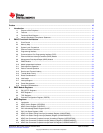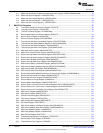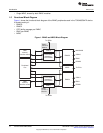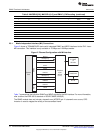
User's Guide
SPRUEF8F–March 2006–Revised November 2010
C6472/TCI6486 EMAC/MDIO
1 Introduction
This document provides a functional description of the Ethernet Media Access Controller (EMAC) and
Physical layer (PHY) device Management Data Input/Output (MDIO) module integrated with
TMS320TCI6486/TMS320C6472 devices. Included are the features of the EMAC and MDIO modules, a
discussion of their architecture and operation, how these modules connect to the outside world, and the
registers descriptions for each module.
The EMAC controls the flow of packet data from the processor to the PHY. The MDIO module controls
PHY configuration and status monitoring.
Both the EMAC and the MDIO modules interface to the DSP through EMIC modules and CPPI buffer
managers that allow efficient data transmission and reception. These two modules are considered integral
to the EMAC/MDIO peripheral.
1.1 Purpose of the Peripheral
The EMAC module is used on TMS320TCI6486/TMS320C6472 devices to move data between the device
and another host connected to the same network, in compliance with the Ethernet protocol.
1.2 Features
Two EMAC modules are integrated with the TCI6486/C6472 device. The basic feature set of the
integrated EMAC modules is:
• Synchronous 10/100/1000-Mbps operation.
• Full duplex Gigabit operation (half duplex gigabit is not supported).
• Little endian and big endian support.
• Both EMAC modules support three types of interfaces to the physical layer device (PHY): reduced
pin-count media independent interface (RMII), reduced pin-count gigabit media independent interface
(RGMII), and source synchronous serial independent interface (S3MII).
• In addition to above four EMAC0 natively supports an additional two interfaces: standard media
independent interface (MII) and standard gigabit media independent interface (GMII).
• EMAC acts as DMA master to either internal or external device memory space.
• Eight receive channels with VLAN tag discrimination for receive quality-of-service (QOS) support.
• Eight transmit channels with round-robin or fixed priority for transmit quality-of-service (QOS) support.
• Ether-stats and 802.3-stats statistics gathering.
• Transmit CRC generation selectable on a per-channel basis.
• Broadcast frames selection for reception on a single channel.
• Multicast frames selection for reception on a single channel.
• Promiscuous receive mode frames selection for reception on a single channel (all frames, all good
frames, short frames, error frames).
• Hardware flow control.
• CPPI 3.0 compliant.
• TI adaptive performance optimization for improved half duplex performance.
• Ethernet Multicore Interrupt Combiner (EMIC) for EMAC and MDIO interrupts.
• Programmable interrupt logic permits the software driver to restrict the generation of back-to-back
interrupts, thus, allowing more work to be performed in a single call to the interrupt service routine.
11
SPRUEF8F–March 2006–Revised November 2010 C6472/TCI6486 EMAC/MDIO
Submit Documentation Feedback
Copyright © 2006–2010, Texas Instruments Incorporated


















